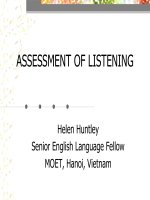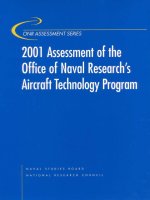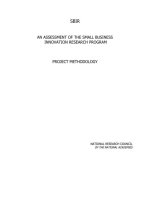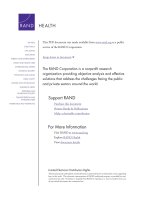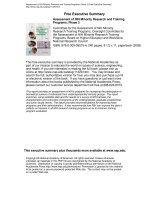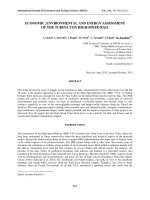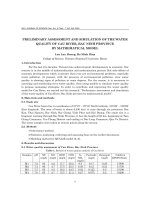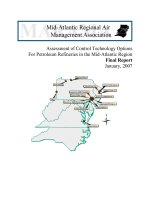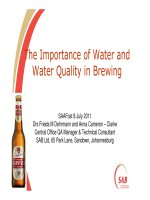Assessment of river water quality using macroinvertebrate organisms as pollution indicators of Cirhanyobowa river, lake Kivu, DR Congo
Bạn đang xem bản rút gọn của tài liệu. Xem và tải ngay bản đầy đủ của tài liệu tại đây (542.49 KB, 13 trang )
Int.J.Curr.Microbiol.App.Sci (2019) 8(4): 2668-2680
International Journal of Current Microbiology and Applied Sciences
ISSN: 2319-7706 Volume 8 Number 04 (2019)
Journal homepage:
Original Research Article
/>
Assessment of River Water Quality using Macroinvertebrate Organisms as
Pollution Indicators of Cirhanyobowa River, Lake Kivu, DR Congo
M. Bagalwa1*, I. Mukumba2, N. Ndahama3, N. Zirirane4 and A.O. Kalala5
1
Department of Biologie, Centre de Recherche en Sciences Naturelles de Lwiro,
Bukva, DR Congo
2
Centre de Recherche pour la Promotion Rural de l’Institut Supérieur de Développement
Rural de Bukavu, D.R. Congo
3
Departement of Environnement, Centre de Recherche en Science Naturelles de Lwiro,
Bukavu, D. R. Congo
4
Faculté des Sciences Agronomiques et Environnement, Université Evangélique en Afrique,
Bukavu, D.R. Congo
5
Université Catholique de Bukavu, D R. Congo
*Corresponding author
ABSTRACT
Keywords
Macroinvertebrate
fauna,
Physicochemical
parameters,
Cirhanyobowa
river, Biological
index
Article Info
Accepted:
20 March 2019
Available Online:
10 April 2019
Biotic indices to monitor water quality are helpful tools for evaluating the health of rivers.
Water quality analysis is mainly done using physical and chemical attributes in the DR
Congo. The objectives of this study were to assess the biological water of Cirhanyobowa
River using macroinvertebrate index and the relationship between physicochemical
parameters and the ecological index from January to December, 2017. Eight
physicochemical parameters and abundance of macroinvertebrates were obtained for 6
sites from upstream to downstream part, with different land uses. Result showed a decrease
in biotic index from upstream (very good water quality) to downstream (bad) due to
human activities along the river flows. Brick mining in the downstream part had more
effects than agriculture in the upstream part. A correlation analysis showed the variation
between the ecological index, abundance of macroinvertebrates and their correlation with
physicochemical parameters in Cirhanyobowa River. The findings show that traits can be
indicative for different kind of stress but that more effort has to be put in gathering data
sets to separate the effect of habitat quality, pollution, and the physicochemical properties
of high mountain rivers.
Introduction
A major concern in several regions of
developing countries are water resource
contamination in which polluted waters pose
serious risks to human health and the
environment. Macroinvertebrates are useful
component to evaluate the state of a river.
2668
Int.J.Curr.Microbiol.App.Sci (2019) 8(4): 2668-2680
Freshwater
benthic
macroinvertebrates
contribute in important ecological functions in
rivers, such as decomposition, nutrient
recycling and play an important role in
aquatic food webs as both consumers and
prey (Mola and Gawad, 2014; Abdel-Gawad
and Mola, 2014). They provide a more
accurate understanding of changing in aquatic
conditions than chemical and microbiological
data, which at least give short-term
fluctuations
(Ravera,
1998,
Ravera,
2000).They may show the cumulative impacts
of multiple stresses, like habitat loss, which
are not always detected by the traditional
water quality assessments using physicochemical measurements. Biological methods
are valuable to determine natural and
anthropogenic influences on water resources
and habitats (Weigel and Robertson, 2007;
Resende et al., 2010). Some species are
indicators of poor water quality such as in the
family Chironomidae (Moss, 1993; Fishar and
Abdel Gawad, 2009) and others species of
Caddisflies are always associated with cleaner
habitat (Rosenberg et al., 2008).
The assemblages of macroinvertebrate are
structured according to physical and chemical
parameters that define habitat and other
biological parameters that influence their
reproductive success (Abdelsalam and
Tanida, 2013).
In Africa countries, many studies have been
assessed for environmental health of rivers
using benthic macroinvertebrate communities
(Guenda, 1996; Kabré et al., 2002; Sanogo,
2014).The index has recently been
successfully used for assessing the ecological
water quality of a river basin in many
countries. Current knowledge of benthic
macroinvertebrates and water ecosystem
health in DR Congo Rivers is still very
fragmentary except the study on the effect of
land use on river quality in river Lwiro
(Bagalwa et al., 2013). This study shows that
the forest site had the highest abundance
values, indicating enrichment or pristine site
were anthropogenic activities are low. And
the agricultural site, however, was
characterized by low species richness for
most groups and very low abundance values.
In Irhambi/Katana sub-county, freshwater
ecosystems have been altered by human
disturbances such as agriculture, urban
development, impoundment, channelization,
brick and mineral mining, forest fire and road
construction. All of these have led to severe
degradation and loss of biodiversity and as a
result these ecosystems have become
unsuitable for human activities such as
drinking, washing and irrigation.
In Irhambi/Katana sub-county studies on
benthic macroinvertebrates in streams and
rivers are sparse. Bagalwa et al., (2012, 2013)
and Ngera et al., (2009 a et b) were the first to
study macroinvertebrates. But these studies
doesn’t use them to assess the pollution status
of streams.
To characterize ecological conditions of rivers
and streams in Irhambi/Katana sub-county,
the development of a single index from
biological and environmental variables is
preferred (Bagalwa et al., 2013; Masese et al.,
2013). This approach involves integration of a
number of structural and functional attributes
of the macroinvertebrate community into a
composite index with the rating of each
metric based on quantitative expectations
(based on comparisons with reference
conditions) of what represents high biotic
integrity. This methods of evaluate water
quality has not been much used in DRC in
general and in Irhambi/Katana in particular.
Biotic indices have not been used in these
studies mostly because of the lack of
knowledge of water resources modelers about
these indices and also limited interval of
limnological measurements in the sub-county.
The objectives of the present study are to
2669
Int.J.Curr.Microbiol.App.Sci (2019) 8(4): 2668-2680
assess the spatial and seasonal variation of
physicochemical
parameters
and
macroinvertebrate diversity and ecological
qualities for different sites in Cirhanyobowa
river.
Materials and Methods
Area of study
Cirhanyobowa is an extensive river that
drains in a rural area and a tributary of Lake
Kivu in the DR Congo side. The river bank is
rich in vegetation with shrubs, grasses and
some cultivated plants such as cassava, maize
and beans and has dominated by mudded
substrate. Ciranyobowa River is found in
Mabingu and Kabamba villages in
Irhambi/Katana sub-county, Southern Kivu
region, DR Congo. Sampling stations were
established according the accessibility,
diversities of substrate and the richness of
macrophytes in the river. Six sampling sites
were determined in Cirhanyobowa River.
Two sites in the upper stream, two in middle
stream and two in downstream (Fig. 1).
Macroinvertebrates
identification
collection
and
The collection of macroinvertebrates was
done from January 2017 to December 2017
using kick-net method. Collection was done
in a standard five minute kick/sweep method
(Armitage et al., 1990). The sampling was
done starting from the upper-stream (Site 1)
to the last sampling point on the downstream
(Site 6) between 7 to 12 pm. The collected
organisms were placed in a container with
water with proper label. Collected specimens
were sorted in the laboratory and were
preserved with 70% ethanol. Identification
was done up to its lowest possible taxa using
the key guides of Micha et Noiset (1982) and
Pennack (1989).
Water sampling and analysis
The physicochemical parameters in the
different site were measured in situ,
temperature and pH were measured by a
digital thermometer and pH-meter (HANNA).
Water samples were collected in glass
stoppered bottles at each sampling site for
dissolved oxygen (DO) using Winkler’s
method (APHA, 2005). The sample used to
determine DO was fixed using 0.5 ml
manganous sulphate followed by 0.5 ml of
Winkler’s reagent.
Samples for determination of total phosphorus
(TP) and total nitrogen (TN) were collected
using acid-washed polyethylene sample
bottles of 500 ml. The samples were
transported in a cool-box to the laboratory for
further analyses. The same water was also use
to analyzed calcium using standard method
(Golterman et al., 1978). Water current
velocity was estimated by timing an orange
flowing through a known distance from a
bridge or vantage point. Depth of water at the
sampling point was measured using a meter.
Water quality index
The collected macroinvertebrates were
grouped into 3 Taxa: Taxa 1, Taxa 2 and Taxa
3 based on their sensitivity or tolerance to
pollution or aquatic disturbance (Barbour et
al., 1999).Taxa 1 includes species belonging
to
orders Ephemeroptera, Plecoptera,
Trichoptera and Coleoptera and was found in
good water quality and are pollution-sensitive
organisms. Taxa 2 species can exist in a wide
range of water quality conditions, or moderate
water quality and include species belonging to
orders Hemiptera, Diptera, Odonataand
Decapoda. Taxa 3 are species that are highly
tolerant to poor water quality. This taxon
includes Tubificida, Gastropoda, Hirudinidae
and
Isopoda.
The
identified
macroinvertebrates were sorted and scored
2670
Int.J.Curr.Microbiol.App.Sci (2019) 8(4): 2668-2680
with their particular points based on Water
quality index (WQI) scores developed by
Armitage et al., (1983); the sum was obtained
and subsequently divided by the number of
species scored. The resulting value is the
WQI and described in Table 1.
BOD, TN, TP and pH) measurements were
evaluated for the variation of the sites with
these measurements. To determine if there is
significant difference between sampling sites,
T-test was employed using 5% level of
significance.
Family biotic index
Results and Discussion
Family Biotic Index developed by Hilsenhoff,
(1977, 1988a, 1988b) was also used as
another means in determining water quality in
the sampling sites. This was obtained by
multiplying the number in each family by
Family-level pollution tolerance value/scores,
summing the products, and dividing by the
total species in the sample. The value
obtained is the FBI and described in Table 2.
Macroinvertebrates diversity
Statistical analysis of data
Data collected was statistically analyzed using
PAST Software to obtain biodiversity indices
such as Evenness, Species Richness index
(d`), Shannon-Wiener index (H’), and
Simpson’s
Dominance
index
(D).To
determine if there is significant difference
between sampling sites, T-test was employed
using 5% level of significance. The diversity
values for Shannon-Weiner (H’) were
classified based on the scale developed by
Fernando in Cuadrado and Calagui (2017)
and described in Table 3.
Six
water
quality
parameter
mean
measurements (temperature, DO, BOD, TN,
TP and pH) to determine if there is any
significant difference in these measurements
among the stations, between the months, if
there is any interaction between stations and
the months sampled. Further analysis of the
above six water quality parameters related to
the stations was done with multivariate
method using PAST Software. Person
correlation analysis of the sites and six mean
water quality parameters (temperature, DO,
A total of 4314 macroinvertebrate individuals
belonging to 15 orders and 41 families. The
distribution
of
different
family
of
macroinvertebrate and their specific richness
on families’ level are present in table 1.
Higher taxa were collected at Batanga (944
individual, upstream site 1) during the
sampling period and the low taxa was
recorded at Bucecebe (509 individual,
downstream
site
6)
in
the
river
Cirhanyobowa. The total number of orders is
15
with
7
main
groups
include
Ephemeroptera,
Plecoptera,
Odonata,
Trichoptera,
Diptera,
Coleoptera
and
Hemiptera. Lepidomastidae was the most
abundant family (1572 individuals), followed
by
Petaluridae
(786
individuals),
Coenagrionidae (616 individuals) and
Hydropsychidae (258 individuals). The
seasonal change ranged from 3205 and 1109
individuals during wet and dry seasons,
respectively. The highest richness was
recorded at Batanga (37) while the lowest was
at Magenge (15).
Physicochemical Parameters
High temperature was recorded at Bucecebe
(20.7±0.4oC) the outlet of the river to Lake
Kivu. While the lowest temperature was
record up stream at Batanga and Kagomero
(14.63±0.3oC). Bucecebe site is located at
high altitude in Cirhanyobowa river at the
edge of Kahuzi/Biega National Park. At the
2671
Int.J.Curr.Microbiol.App.Sci (2019) 8(4): 2668-2680
site no human activities are done.
Temperature at Bucecebe site with average
temperature of 20.7oC increases the
metabolism of aquatic insects which reduce
the DO concentration in the water and
abundance of species. pH is also follow the
same trend as temperature with the highest at
Bucecebe and the lowest at Batanga and
Kagomero. The trend for DO is different, the
high values was recorded at the upstream
(Batanga) and the lowest at downstream at
Bucecebe.
Calcium concentration in all the site doesn’t
change much even TP. But TN is high
downstream at Bucecebe then in others
sampling site during the sampling period. The
depth varied from site to site in general even
the current velocity. The high current velocity
was found at Batanga site and the lowest at
Bucecebe.
The results reveal that the abundance of
aquatic macroinvertebrates depends on the
physicochemical factors of the river
coursesuch as water temperature, water
velocity, no deeper water, nitrogen,
phosphorus, calcium concentration and high
dissolved oxygen level. Anthropogenic
activities reduce the abundance of sensitive
macroinvertebrates in the course of the river.
Due to this some no tolerant taxa disappear in
the river sites and with found tolerant taxa
such the order of Diptera, Ephemeroptera and
Coleoptera.
Diversity and biotic indices
Batanga Kagomero Cabadagi Magenge Ruvoma Bucecebe
Index water quality 4.70
4.91
5.04
4
4.88
5.32
Shannon H’
2.546
1.76
1.99
1.69
1.985
1.915
Highest diversity index (H’=2.546) was
recorded at Batanga site and the lowest
diversity index recorded at Magenge site
(H’=1.69) as stated in Table 3. Using index
water quality all the sites was good or very
good according to the classification. A study
about diversity and abundance of aquatic
macroinvertebratesin Brazil reports that the
sampling station with the highest dissolved
oxygen level had the highest Shannon-Weiner
diversity index (Silva et al., 2009).Higher
Shannon indices indicate less stress in
ecosystems, higher abundance and more even
distribution of species in the ecosystem. This
was observed in the site of Batanga with high
DO and low water quality index (4.70).
Proportions of species belonging to
Ephemeroptera varied between 0.36% and
7.75%. The lowest value was observed at
Kagomero and the highest value at Batanga,
differences between downstream stations
(Bucecebe) and stations upstream (Batanga)
were large. Differences among sampling sites
were significant (p<0.05). For the species
belonging to trichoptera, they was ranged
from 45.54% at Batanga and to 55.84% at
Kagomero. Differences between downstream
stations (Bucecebe) and stations upstream
(Batanga) were not large. Differences among
sampling sites were not significant (p>0.05).
And the proportion of the species belonging
to Diptera was high at the site of Ruvoma
(9.05%) and Batanga (8.71%) than the site
downstream at Bucecebe (0.78%) and
Magenge (1.01%).
Correlations
parameters
abundance
between physicochemical
and
macroinvertebrate
The effect of physicochemical factors on the
abundance of macroinvertebrate has been
2672
Int.J.Curr.Microbiol.App.Sci (2019) 8(4): 2668-2680
investigate in this studies in Cirhanyobowa
river. Spearman’s correlation coefficients
between physicochemical parameters and
macroinvertebrate abundance in the site are
presented in Table 4.
The results reveal that the abundance of
macroinvertebrate is high when water
temperature increases, pH, TN and Depth are
negatively correlated to macroinvertebrate
abundance. The negative correlation (r=0.946) with temperature is contrary to the
results observed elsewhere a strong, positive
correlation between water temperature and
abundance of macroinvertebrate (r=0.937)
was observed in Ethiopia (Abrehet et al.,
2014).
The same observation was also observed for
the correlation of depth and abundance of
macroinvertebrate while Abrehet et al.,
(2014) found a positive correlation but for
Cirhanyobowa River we found negative
correlation. DO and water velocity are
positively correlated with abundance of
macroinvertebrate. High dissolved oxygen
(DO)
level
are
preferable
by
macroinvertebrate as also found by Nur et al.,
(2017).
The site of Batanga (upstream site) has high
abundance and diversity of macroinvertebrate
with high level of DO but with high water
velocity. This is in disagreement with the
result of Nur et al., (2017), who found that the
abundance of aquatic macroinvertebrate is
high when water temperature increases, low
water velocity, high dissolved oxygen (DO)
level and deeper water. The site downstream
with high temperature was colonized with
tolerant taxa such as Lepidomastidae and
Coenagrionidae but the site upstream with
low temperature and high DO was colonized
by no tolerant taxa. These sites was not
disturbed by human activities and located at
high altitude. Stoyanova et al., (2014) found
that some aquatic macroinvertebrates are
affected by conditions that reduce the
dissolved oxygen of the water, like pollution;
therefore
the
presence
of
these
macroinvertebrates indicates high stream
quality.
Temperature is also affect abundance of
macroinvertebrate in Cirhanyobowa river as
observed in this table. High temperature affect
negatively
the
abundance
of
macroinvertebrate in Cirhanyobowa river
contrary to the found of Abrehet et al., (2014)
and Nur et al., (2017). Burgmer et al., (2009)
shown that the emergence of many aquatic
macroinvertebrate is influenced by water
temperature and leads to earlier emergence of
insects for example, egg may hatch when
temperature reaches a certain level.
The level of temperature was not determined
such as we can compare the optimal
temperature with the temperature obtained at
Batanga site upstream. This show that the
abundance of macroinvertebrate in a site is a
combination of environmental factors but not
one factors alone.
Table.1 Water quality index scores and indication
Score
7.6 – 10
5.1 – 7.5
2.6 – 5.0
1.0 – 2.5
0
Indication
Very clean water
Rather clean-clean water
Rather dirty-water average
Dirty water
Very dirty water (no life at all)
2673
Int.J.Curr.Microbiol.App.Sci (2019) 8(4): 2668-2680
Table.2 Water quality using the family-level biotic index
Biotic
0.00–3.50
3.51–4.50
4.51–5.50
5.51–6.50
6.51–7.50
7.51–8.50
8.51–10.0
Index Water quality
Excellent
Very good
Good
Fair
Fairly poor
Poor
Very poor
Degree of organic pollution
No apparent organic pollution
Possible slight organic pollution
Some organic pollution
Fairly significant organic pollution
Significant organic pollution
Very significant organic pollution
Severe organic pollution
Table.3 H’ diversity value and its qualitative equivalence
H’ value
>3.5
3.0-3.49
2.5-2.99
2.0-2.49
<1.99
Relative values
Very high
High
Moderate
Low
Very low
Table.4 Number and specific richness of macroinvertebrate collected at 6 sites in Cirhanyobowa
River
Taxa
O. Plecoptera
F. Isogeninae
F. Nemourinae
O. Trichoptera
F. limnephilidae
F. Rhyacophilidae
F. Lepidostomatidae
F. Leptoceridae
F. Hydropsychidae
F. Philopotamonidae
F. Polycentropodidae
O. Diptera
F. Psychodidae
F. Thaumaleidae
F. Similidae
F. Ceratopogonidae
F.Chironomidae
F.Tabanidae
F. Tipulidae
Batanga Kagomero Cabadagi Magenge Ruvoma Bucecebe
9
2
0
0
0
0
0
0
0
0
0
0
20
3
247
15
88
53
3
12
0
396
4
41
11
0
11
0
241
3
62
15
0
5
0
278
0
67
17
0
2
4
227
6
43
13
0
19
0
183
5
57
6
0
14
1
50
11
0
4
2
19
0
0
4
23
0
1
6
0
40
1
0
0
0
6
0
0
0
0
0
1
11
0
0
0
47
0
0
0
0
1
0
3
0
0
2674
Int.J.Curr.Microbiol.App.Sci (2019) 8(4): 2668-2680
O. Hemiptera
F. Mesovelidae
F. Naucoridae
F. Corixidae
F. Pleidae
F. Gerridae
F. Nepidae
F, Elmidae
O. Lepidoptera
F. Pyralididae
O. Ephemeroptera
F. Heptagenidae
F. Baetidae
F. Caenidae
F. Adenophlebiodidae
F. Hastaperdidae
O. Odonate
F. Aeschnidae
F. Petaluridae
F. Gomphidae
F. Coenagrionidae
O. Coleoptera
F. Elimidae
F. Gyrinidae
O. Megaloptera
F. Corylidae
O. Lumbriculida
F. Lumbriculidae
O. Gordiida
F. Gordidae
O. Arhynchobdellide
F. Glossiphoniidae
O. Arenida
F. Agynectidae
O. Hemiptera
F. Nepidae
O. Decapoda
F. Potamonidae
Number of individual
Specific richness
1
0
4
6
1
1
1
0
0
0
0
0
1
0
1
1
0
0
0
0
1
0
0
0
0
0
0
0
0
0
0
0
0
0
0
1
0
2
0
0
0
2
5
1
0
0
0
0
30
23
11
6
3
0
3
0
0
0
4
6
2
0
0
3
1
2
0
0
0
6
0
0
0
1
9
2
0
0
2
179
60
49
2
144
31
117
4
181
31
61
9
112
31
155
2
93
28
128
0
77
23
106
9
0
3
4
10
2
3
0
1
0
1
1
2
0
0
0
0
0
1
3
0
0
8
2
6
2
2
0
7
2
0
0
0
0
15
1
1
3
7
3
0
5
0
2
1
0
0
0
19
942
37
4
831
23
3
696
24
0
693
15
0
641
17
0
509
22
2675
Int.J.Curr.Microbiol.App.Sci (2019) 8(4): 2668-2680
Table.5 Physicochemical characteristics of sampling sites in Cirhanyobowa River
Batanga
Temperature (oC)
pH
Dissolved
(mg/L)
Oxygen
Calcium (mg/L)
Total phosphorus
(µmol/L)
Total
nitrogen
(µmol/L)
Depth (cm)
Current
(m/s)
velocity
Kagomero
Mo
y
14.
63
6.9
3
8.9
Eca
rt
0.39
Ma
x
15
Mi
n
14
0.26
7.2
6.5
2.73
13.
4
0.7
9
0.0
6
0.1
0.5
2
57.
67
1.0
5
0.21
Cabadagi
Eca
rt
0.39
Ma
x
15
Mi
n
14
Mi
n
16
0.26
7.2
6.5
6.5
5.8
Mo
y
14.
63
6.9
3
8.9
2.73
13.
4
5.8
6.7
0.9
2
0.0
9
0.6
8
0.0
4
0.7
9
0.0
6
0.1
0.9
2
0.0
9
0.6
8
0.0
4
0.3
1
52
3.78
0.7
9
63
0.44
1.6
0.5
0.5
2
57.
67
1.0
0.21
3.78
0.7
9
63
0.4
1.6
0.02
0.02
Magenge
Mo
y
17.
98
6.7
5
7.3
8
Eca
rt
0.72
0.42
Ma
x
19.
3
7.1
0.66
8.4
0.3
2
0.0
3
0.5
7
0.0
6
0.23
0.8
0.01
0.0
8
0.3
1
52
0.3
1
60
0.4
4
82.
05
0.8
8
0.22
0.6
52
85.
3
1.1
0.5
0.5
2.89
0.19
Mo
y
19
Eca
rt
0.59
7.0
8
7.0
8
Ruvoma
Mi
n
18
0.35
Ma
x
19.
8
7.5
0.9
0.7
2
0.0
6
0.28
0.4
1
79.
22
0.9
7
0.25
0.02
4.57
0.21
Bucecebe
Eca
rt
0.23
Ma
x
20
6.5
Mo
y
19.
9
7.3
0.45
7.6
Mi
n
19.
4
6.4
8
5.6
6.6
0.68
7.2
5.3
1.0
4
0.0
8
0.3
2
0.0
4
0.9
0.13
0.8
0.1
2
0.15
1.0
8
0.4
2
0.7
7
85.
3
1.3
0.1
6
73
0.2
8
66.
83
0.8
5
0.18
0.5
4.31
71
0.0
2
59
0.22
1.1
0.5
0.7
0.0
4
Mo
y
20.
7
7.4
8
6.5
5
Eca
rt
0.4
Ma
x
21
Min
0.38
7.9
6.9
0.42
7.2
6.1
0.9
6
0.0
5
0.2
1.2
8
0.0
8
0.76
66
160.
7
6.19
39
4
89
0.311
0.21
1.1
0.6
79.
5
0.8
3
0.02
Table.6 Percentage of species belonging to the families of Ephemeroptera, Trichoptera and Diptera in the different sites in
Cirhanyobowa River
Batanga Kagomero Cabadagi Magenge Ruvoma Bucecebe
7.75
0.36
1.72
0.87
0.94
2.36
%Ephemeroptera
45.54
55.84
47.7
52.96
46.02
53.05
%Trichopera
8.71
5.66
6.75
1.01
9.05
0.78
%Diptera
2676
20
0.03
71
Int.J.Curr.Microbiol.App.Sci (2019) 8(4): 2668-2680
Table.7 Correlation between some physicochemical parameters and number of individual
macroinvertebrate in Cirhanyobowa River
Tempe_(oC)
Temp_(oC)
pH
DO
_(mg/L)
Calcium_(mg/L)
TP
_(µmol/L)
TN
_(µmol/L)
Depth_(cm)
Velocity_(m/s)
0
pH
0.712
0
DO_(mg/L)
-0.99
-0.66
0
Calcium_(mg/L)
0.333
0.892
-0.276
0
TP _(µmol/L)
0.287
0.269
-0.347
0.283
0
TN _(µmol/L)
0.537
0.729
-0.461
0.612
-0.353
0
Depth_(cm)
0.761
0.187
-0.763
-0.262
-0.215
0.391
0
Velocity_(m/s)
-0.91
-0.578
0.918
-0.258
-0.333
-0.534
-0.704
0
-0.946
-0.709
0.927
-0.361
-0.133
-0.679
-0.754
0.906
N_of_individual.
N_of_ind.
Fig.1 Map of river Cirhanyobowa and sampling site
2677
0
Int.J.Curr.Microbiol.App.Sci (2019) 8(4): 2668-2680
Water velocity is one of the factors that effect
on the abundance of aquatic insects. But Nur et
al., (2017) found that there was a strong,
negative correlation between water velocity and
aquatic macroinvertebrate (r=-0.969). But in
Ciranyobowa River we found a contrary
because water current velocity is positively
correlated with abundance of macroinvertebrate.
Some taxa of macroinvertebrate colonized
micro-habitat with high current velocity and are
adapted to this environment. Scheibler et al.,
(2014) stated that a pH range of 6.5 to 8.0
provides adequate protection for the life of
macroinvertebrates. Thus, all of the six sites in
Cirhanyobowa River are still inthe acceptable
range of pH to aquatic life which all freshwater
aquatic life is unharmed and no bad impacts
occur. But, the correlation of pH and abundance
of
macroinvertebrates
was
negatively
correlated. These are justified by observed
ascertainment before as correlation is not due to
individual effect of physicochemical parameters
but with a group of parameters. Based on this
study, it can be concluded that the physical
parameters of Cirhanyobowa River which are
water temperature, pH, TP, TN, water velocity,
water depth and dissolved oxygen level have
strongly influence the abundance of aquatic
macroinvertebrate. Thus, we can develop the
alternative bioindicator for water condition by
using aquatic macroinvertebrate.
Acknowledgement
The authors are grateful to the technicians of the
Laboratory of Malacology and Mr Cinyambiriri
for providing most materials used for the
collection and analyses of samples in this study.
References
Abdel-Gawad S. S., Mola H. R. A., 2014.
Macrobenthic invertebrates in the main
channel of Lake Nasser, Egypt,
Egyptian Journal of Aquatic Research,
40, 405-414.
Abdelsalam, K., Tanida, K., 2013. Diversity
and spatio-temporal distribution of
macro-invertebrates communities in
spring flows of Tsuya Stream, Gifu
prefecture, central Japan. Egypt. J.
Aquat. Res. 39, 39–50.
Abrehet K. M., Ayalew W., Minwyelet M.,
Jacobus V., 2014. Spatial and seasonal
variation in the macro-invertebrates and
physico-chemical parameters of the
Enfranz River, Lake Tana Sub-Basin
(Ethiopia).
Ecohydrology
&
Hydrobiology,
Andem A. B., Okorafor K. A., Udofia U., Okete
K. A., Ugwumba A. A. A., 2012.
Composition, distribution and diversity
of benthic macroinvertebrates of Ona
River, Southwest, Nigeria. European
Journal of Zoological Research 1, 2, 4753.
APHA, 2005. Standard Methods for the
Examination of Water and Wastewater.
21st Edition, American Public Health
Association/American Water Works
Association/Water
Environment
Federation, Washington DC.
Armitage P. D., Moss D., Wright J. F., Furse M.
T., 1983. The performance of a new
biological water quality score system
based on macroinvertebrates over a
wide range of unpolluted running-water
sites. Water Research, 17, 333-347.
Armitage P. D., Pardo I., Furse M. T., Wright J.
F., 1990. Assessment and prediction of
biological quality: A demonstration of a
British macroinvertebrate-based method
in two Spanish rivers. Limnetica, 6,
147-156.
Bagalwa M., Karume K., Bayongwa C.,
Ndahama N., Ndegeyi K., 2013. Landuse Effects on Cirhanyobowa River
Water Quality in D.R. Congo. Greener
Journal of Environment Management
and Public Safety, Vol. 3, 1, 21-30.
BagalwaM., Zirirane N., PaulsS. U., Karume
K.,
Ngera
M.,
Bisimwa
M.,
MushagalusaN. G., 2012. Aspects of the
Physico-Chemical Characteristics of
Rivers in Kahuzi-Biega National Park,
Democratic Republic of Congo. Journal
of Environmental Protection, 3, 15901595.
2678
Int.J.Curr.Microbiol.App.Sci (2019) 8(4): 2668-2680
Barbour M. T., Gerritsen G. E., Snyder B. D.,
Stribling
J.
B.,
1999.
Rapid
Bioassessment Protocols for Use in
Streams and Wade able Rivers:
Phytoplankton,
Benthic
Macroinvertebrates and Fish. Second
Edition. EPA 841- B-99-002., U.S.
Environment Protection Agency; Office
of Water; Washington, D.C.
Burgmer T, Hillebrand H,, Pfenninger M.,
2009.
Effects
of climate-driven
temperature changes on the diversity of
freshwater macroinvertebrates. Global
change and conservation ecology.
Cuadrado J. T., Calagui L. B., 2017. Aquatic
macroinvertebrates
composition,
diversity and richness in Agusan river
tributaries, Esperanza, Agusan del Sur,
Philippines. Journal of Biodiversity and
Environmental Sciences, 10, 3, 25 – 34.
Fishar, M.R.A., Abdel Gawad, S.S., 2009.
Macroinvertebrate
communities
associated with the macrophyte
Potamogeton pectinatus L. in Lake
Manzala, Egypt. Global Vetrinaria, 3, 3,
239–247.
Golterman, H.L., R.S. Clymo, M.A.M. Ohnstad,
1978, Methods for physical and
chemical analysis of fresh waters,
Blackel scientific publication, London,
213 p.
Guenda W., 1996. Etude faunistique,
écologique et de la distribution des
insectes d’un réseau hydrographique de
l’Ouest africain: Mouhoun (Burkina
Faso);
Rapport
avec
Simulium
damnasum Theobald, vecteur de
l’onchocercose. Thèse Doctorat d’Etat
és sciences, Université de Droit,
d’Economie et des sciences D’AixMarseille III, France
Hilsenhoff W. L., 1977. Use of arthropods to
evaluate water quality of streams.
Technical Bulletin No. 100, Department
of Natural Resources, Madison,
Wisconsin.
Hilsenhoff W. L., 1988a. Seasonal correction
factors for the biotic index. Great Lakes
Entomologist, 21, 9–13.
Hilsenhoff W. L., 1988b. Rapid Field
Assessment of Organic Pollution with a
Family-level Biotic Index. Journal of
American Benthological Society, 7, 1,
65-68.
Kabré T. A., Diguingué D., Bouda S., 2002.
Effet du rétrécissement de la superficie
d'eau sur les macroinvertébrés du lac de
barrage de la Comoé, Sud-ouest du
Burkina Faso. Science et Technique,
série Sciences Naturelles et Agronomie,
26, 1, 37- 49.
Masese, F.O., Omukoto J.O., Nyakeya, K.,
2013. Biomonitoring as a prerequisite
for sustainable water resources: a
review of current status, opportunities
and challenges to scaling up in East
Africa. Ecohydrology & Hydrobiology
13, 173–191.
Micha J. C., Noiset J. L., 1982. Evaluation
biologique de la pollution de ruisseaux
et rivières par les macro-invertébrés
aquatiques. Probio Revue, 5, 142 p.
Mola H. R. A., Gawad S. S. A., 2014. Spatiotemporal variations of macrobenthic
fauna in Lake Nasser khors, Egypt.
Egyptian Journal of Aquatic Research,
40, 415–423.
Moss, B., 1993. Ecology of Freshwater-Man
and Medium, second ed. Black well
Scientific Publication, London.
Ngera M. F., Baluku B., Cammaerts D.,
Bisimwa M., 2009a. Evaluation
biologique de la pollution de la rivière
Kalengo par les invertébrés aquatiques.
Cahier du CERUKI, Numéro special
CRSN-Lwiro, 89 – 94
Ngera M. F., Camnaerts D., Bisimwa M. A.,
Baluku B., 2009b. Etude comparative de
macro-invertebres benthiques de trois
cours d’eau du bassin versant du Lac
Kivu en RDCongo. Cahier du CERUKI,
Numéro special CRSN-Lwiro, 95 – 107
Nur A. H., Norliza Y., Nadia N. M.,
Muhammad A. F., 2017. Influence of
physicochemical
parameters
on
abundance of aquatic insects in rivers of
Perak, Malaysia. International Journal
2679
Int.J.Curr.Microbiol.App.Sci (2019) 8(4): 2668-2680
of Advances in Science Engineering and
Technology, 5, 4(1), 68 – 72.
Pennak, R.W., 1989. Freshwater Invertebrates
of the United States, 3rd ed. J. Wiley &
Sons, New York, 628 pp.
Ravera, O., 1998. Utility and limits of
biological and chemical monitoring of
the aquatic environment. Annal.
Dichim. 88, 909– 913.
Ravera, O., 2000. Ecological Monitoring
Tailormade III. International Workshop
on Information for Sustainable Water
Management, pp. 157–167.
Resende P. C., Resende P., Pardal M., Almeida
S., Azeiteiro U., 2010. Use of biological
indicators to assess water quality of the
Ul River (Portugal). Environmental
Monitoring and Assessment, 170, 1-4,
535–544.
Rosenberg, D.M., Resh, V.H., King, R.S., 2008.
Use of aquatic insects in biomonitoring.
In: Merritt, R.W., Cummins, K.W.,
Berg, M.B. (Eds.), An Introduction to
the Aquatic Insects of North America,
fourth ed. Kendall/Hunt, Dubuque,
Iowa, pp. 123–137.
Sanogo
S.,
2014.
Inventaire
des
macroinvertébrés de différents plans
d’eau du bassin de la Volta en vue de
l’identification
des
taxons
bioindicateurs dans un continuum
barrage hydroagricole effluent- fleuve
au Burkina Faso. Thèse de doctorat
unique en développement rural,
Ouagadougou.
Scheibler E. E., Claps M. C., Roig-Junet S. A.,
2014.Temporal and altitudinal variation
in
benthic
microinvertebrate
assemblages in an Andean river basin of
Argentina. Journal of Limnology, 73, 1,
92-108.
Silva F.L., Moreira D.C., Ruiz S.S., Bochini G.
L., 2009. Diversity and abundance of
aquatic macroinvertebrates in a lotic
environment in Midwestern São Paolo
State, Brazil. Ambi-Agua, Taubaté 4(1):
37-44.
Stoyanova T., Vidinova Y., Yaneva I.,
Tyufekchieva V., Parvanov D., Traykov
I., Bogoev V., 2014. Ephemeroptera,
Plecoptera and Trichoptera as indicators
for ecological quality of the Luda Reka
River, Southwest Bulgaria. Acta
Zoologica Bulgarica 66, 2, 255-260.
Weigel B. M., Robertson D. M., 2007.
Identifying biotic integrity and water
chemistry relations in nonwadeable
rivers of Wisconsin: toward the
development of nutrient criteria.
Environmental Management, 40, 4,
691–708.
How to cite this article:
Bagalwa, M., I. Mukumba, N. Ndahama, N. Zirirane and Kalala, A.O. 2019. Assessment of River
Water Quality using Macroinvertebrate Organisms as Pollution Indicators of Cirhanyobowa River,
Lake Kivu, DR Congo. Int.J.Curr.Microbiol.App.Sci. 8(04): 2668-2680.
doi: />
2680
